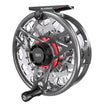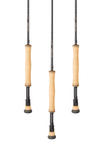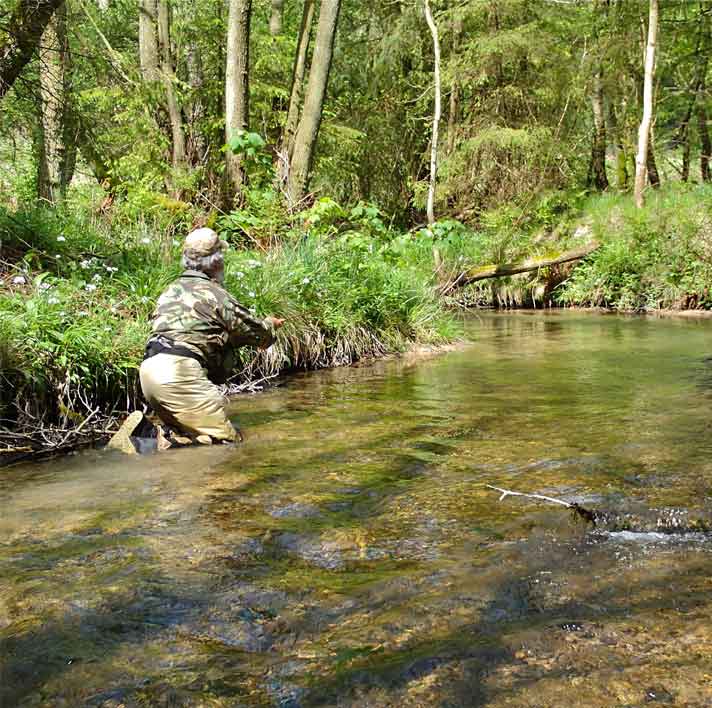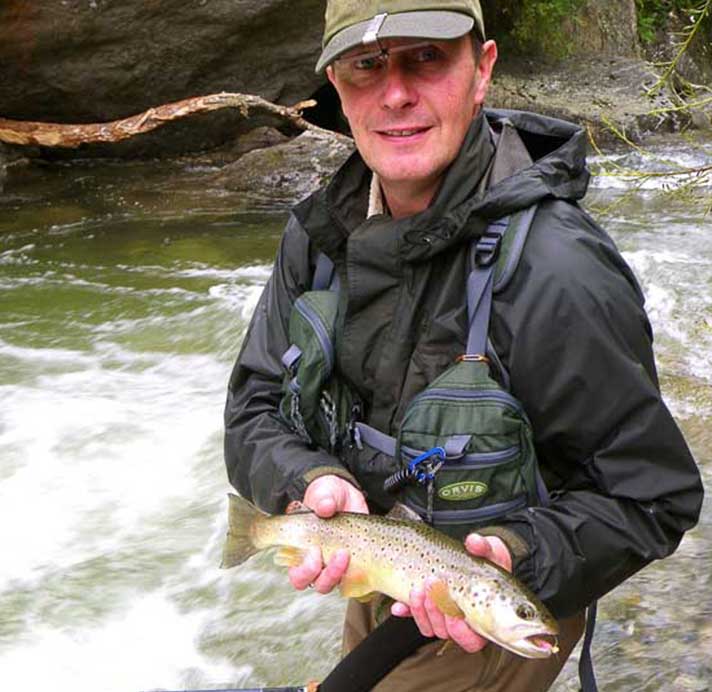Tenkara fishing with its short, fixed line has taught me a lot about the advantages of fishing at close range. Even before my introductory forays into Tenkara I was aware of many of the advantages of fishing a short line but often tended to fish at too great a distance due to my fear of scaring the fish that I was targeting. However I now appreciate more fully the cogent reasons for fishing at close range (ideally 30’/10m or less). So what are they?
- Drag avoidance is probably the primary advantage. In many cases even the slightest unnatural drift of a dry fly or subsurface fly can result in rejection by the fish. This is caused by the actions of rogue currents pulling on the tippet & leader, which drags the fly unnaturally across the flow. Fishing at close range with a long rod & as light a line as possible facilitates the holding of most if not all of the line off these conflicting currents. This is why I love Tom’s Sunray 10’ 2 weight Jeremy Lucas rod teamed up with a 1 weight Jeremy Lucas micro thin line plus 12’ of leader & tippet, or even better a micro nymph line with the same leader setup. Better still is the Sunray ZERO 10’ 6” to 11’ 6” rod teamed up with either a micro nymph line & 12’ leader or a 2.5 weight/10lb/0.25mm/1x level fluorocarbon line & 4’ or so of tippet. Of course, where the fish aren’t too big & in calm conditions then Tenkara is the ultimate in drag-free presentation. I should add that some folks prefer to fish with a line one line weight heavier than that designated for the rod when fishing at close range to aid rod-loading (for example a 3 weight line on a 2 weight rod); alternatively a line such as the Sunray Micro Thin Stuart Crofts line which is designed to load the rod quickly at close range is a good choice for such folks. My personal preference to use lines 1 to 2 weights lighter than the rod’s designation is because I use the Italian Style of casting which generates much greater rod loading than normal & the lighter lines are far easier to hold up, off the water surface.
- Fine manipulation of my fly is also more easily achieved when fishing at close range with a long rod & light lines. Although, as mentioned in an earlier blog a drag-free drift is often required to fool fish there are many times when the application of subtle movement to our flies can make all the difference between a fish taking our offering or ignoring it. Only yesterday, whilst fishing a size 24 CdC Midge to some very fussy trout on a baking hot, sunny day & on a river down to its bare bones, I had several fish that refused a dead-drifted fly but avidly engulfed my twitched fly.
- Precision casting can be essential at times. Grayling in particular can be loath to move more than a few centimetres off line to take a dry fly. Also when trout are preoccupied on tiny midges, aphids or large falls of spent spinners they tend to ‘sit’ just below the river surface & as a result their field of vision is very limited so a fly even 30cm/12” away may not be noticed. It is far easier to determine the precise location of a rising fish at close range & then it is also much easier to cast accurately to that fish when fishing at close range.
- Seeing the take, particularly when sight-fishing subsurface flies is also much easier at close range
- Effective striking & hooking becomes increasingly problematic the greater the distance that one fishes. More line equals more inertia & more surface tension to be overcome, plus more slack line to be taken up, all of which reduce the force of the strike. The surface tension problem can be significantly reduced by greasing up the fly line & as much of the leader & tippet as possible.
There are of course some disadvantages of close range fishing:
- The main one is the risk of scaring the fish, particularly in smooth flowing, clear waters. In an earlier Blog I wrote in detail about stealth but it is worth repeating much of what I said there since a scared fish, even if it doesn’t bolt for cover, can not be caught. So here are the main points:
- Wear subdued/camouflaged clothing to match the background. If in a boat or on a high bank silhouetted against the sky this might be light grey or blue (think of the colour of a heron!).
- Use any possible cover, either hide behind it if bank fishing or use a suitable background if in the open or wading.
- Move incredibly slowly (think again of the heron) & particularly so if wading in the slow, smooth water of pools (sending ripples along a slow stretch of water is a sure way to let the fish know that you are there).
- Avoid any unnecessary movements.
- Use a wading staff when wading to help avoid any stumbles.
- Avoid false casting.
- Deep wading can lower your profile, getting you below the fish’s cone of above surface-vision.
- Use kneepads to lower your profile when bank fishing or wading in shallow water.
- Another disadvantage at close range is an increased risk of tippet breakage since there is less stretchy, shock absorbing line between you & the fish. So fish with soft, light-line rods that will help to avoid breakage on the strike or when playing big fish on a short line (the Sunray 10’ 2 weight JL Volition & Sunray 10’ 6” to 11’ 6” ZERO rods are perfect for protecting light tippets at close range). Also choose tippet material that has a decent amount of stretch (some super thin, super strong tippets are prestretched & although very strong for their diameter against a steady pull they do not perform well against sudden impacts. Long tippets also help, as they are the part that stretches most when put under tension.
So there you have it; many years ago I was a wack it to the horizon guy whether fly fishing or fishing for carp with coarse gear; nowadays I fish at close range when ever possible & I catch far more fish.

1. 10’ 2 weight Sunray Volition & 1 weight Micro Thin Jeremy Lucas line, a perfect combination for delicate close range fishing, but also capable of fishing at distance when required.

2. Sunray ZERO rod & Micro Nymph line, another great setup for delicate close range work.

3. Sunray ZERO rod & 10lb/0.25mm/1x Pink Fluorocarbon Tenkara casting line 25’ long, the ultimate in super-delicate, close range Western fly fishing gear.

4. The Sunray ZERO rod at 11’ 6” with 0.25mm Fluorocarbon casting line plus 4’ of tippet & a small dry fly, in action on the upper Tees where close range fishing is vastly more effective than fishing at longer range.

5. The author camouflaged & keeping a low profile whilst fishing at close range.






















